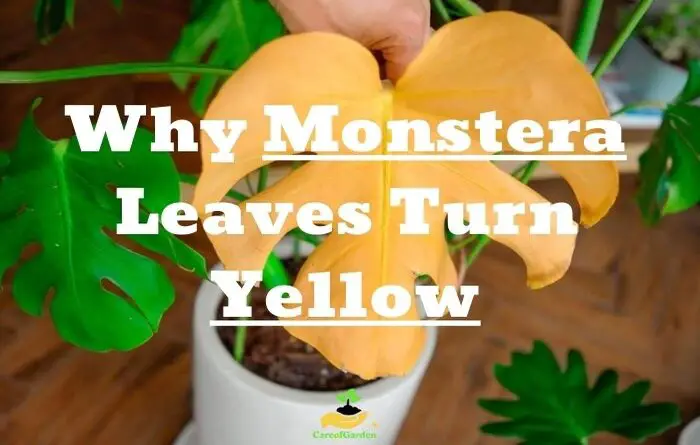10 Reasons Why Monstera Leaves Turn Yellow [Here’s How to Fix It!]
Does your Monstera have yellow leaves? This is only the consequence of a crop error, a disease or other. A message that the plant sends to tell us that something is wrong. To help you understand why leaves are yellowing I’ve create a list of the 10 Most Common Reasons Why Monstera Leaves Turn Yellow.
| Reasons Monstera Leaves Turn Yellow |
|---|
| 1. Root rot |
| 2. Waterlogging |
| 3. Old leaves change |
| 4. Excessive light (sunburn) |
| 5. Low temperatures |
| 6. Fungal diseases |
| 7. Over fertilization |
| 8. Bacterial infections |
| 9. Nutrient deficiency |
| 10. Pest Infestation (Spider Mites) |
Reasons Why Monstera Leaves Turn Yellow
Here we are finally at the list of the 10 main causes of yellow leaves of Monstera Deliciosa or Adansonii:
1. Root rot
Root rot is one of the worst reasons that can be encountered, whether it is Monstera adansonii or Monstera deliciosa or other plants. This disease is caused by fungi that proliferate in humid environments and pass through the cell walls of the plant thanks to their zoospores.
They practically settle in the plant through the water, they do not need cuts or breaks in the tissues to enter.
As mentioned before, the cause of root rot is water stagnation .
The fungi that most commonly cause root rot in Monstera are:
- Pythium,
- Rhizoctonia,
- Phytophtora.
But there are others too.
Once inside the plant they spread to the surrounding tissues causing them to rot.
Not infrequently, the resulting lesions become the entry point for other even more dangerous fungal pathogens. Like the Fusarium which, once it has entered the roots, spreads to the rest of the plant through its lymphatic channels.
The visible symptoms in the aerial part are yellow leaves, necrotic (black) spots and loss of turgor. The plant cannot absorb water and nutrients because the roots are rotten.
Inside the pot we will find a rotten root system, recognizable by the brown color and the soft and slimy texture to the touch.
How to fix Monstera yellow leaves due to Root rot
Once you have ascertained that the cause of the yellow leaves in your Monstera is a radical problem, you need to go and remove the damaged parts.
If we limited ourselves to repotting our Monstera with a new soil , we would seriously risk that the problem recurs and worsens.
To save Monstera leaves suffering from root rot, you must:
- Remove as much soil from the Monstera roots as possible to get a better idea of the extent of the damage.
- Sterilize a pair of scissors with bleach, flame, or alcohol.
- Cut all the rotten roots , they are usually brown, soft and slimy. They may also be dry if you let the substrate dry first.
- Cut off the yellow leaves at the base . First make sure you have sterilized the scissors again.
- Disinfect the Monstera roots by spraying hydrogen peroxide (3% hydrogen peroxide) on them. It will help you kill any bacteria and spores.
- Let the Monstera root system dry for a few hours . Until they are dry to the touch.
- Repot the Monstera in a new pot (or bleach the old one) using a very draining and airy soil.
The same is done if the roots are dry. Provided they have not previously died from rot, being dead they may rot later when wet.
2. Waterlogging
Excess water(waterlogging) is by far the most frequent cause of the appearance of yellow leaves on Monstera. This may be due to too frequent watering , poorly draining soil or because water is left in the saucer .
In any case, the problem is due to water stagnation, which keeps the roots moist for too long and prevents proper oxygenation.
The stagnation of water recreates the ideal conditions for the proliferation of bacteria and fungi. First of all, the root rot caused by Pythium, Rhizoctonia, Phytophtora and others.
Even assuming the roots are not rotten, a soil that is too loaded with water prevents air from circulating inside. In an anaerobic environment (devoid of oxygen) the roots are unable to breathe and to carry out the processes necessary to produce the energy necessary to grow.
The root system “suffocates” , dies and is no longer able to absorb water and nutrients.
The yellow leaves of the Monstera are just a consequence of this.
Obviously, if the cause is too much water, the soil will be wet. Or you know you watered it too much in the previous period.
A second very common symptom is the appearance of necrosis on the leaves. Black spots , which start from the edges of the leaves and gradually widen. In addition, the plant may lose its turgor and soften.
How to fix Monstera yellow leaves due to Waterlogging
If your Monstera has yellow leaves from standing water, take the plant out of the pot and check the roots.
In the best of cases the root system is healthy and you just need to not wet the Monstera again until the soil is completely dry.
In any case, check whether the roots are already beginning to rot or become moldy. If you detect a musty odor or soggy roots, remove all of the soil and generously trim away any damaged tissue. Then plant the Monstera in fresh substrate.
Then resume watering the Monstera carefully to prevent the problem from recurring. And remember, it’s easier to get a dehydrated plant back than one that’s watered too much.
3. Old leaves change
If the oldest leaf (the one closest to the base) turns yellow while the rest of the Monstera has a healthy and florid appearance, it is most likely a simple leaf change .
In this case there is nothing to worry about. It is part of the life cycle of the plant, it is normal.
As the plant grows and produces new leaves, the older ones turn yellow and then dry out.
How to fix Monstera yellow leaves due to Old leaves change
At your discretion you can choose whether to cut the yellowed leaf or wait for it to dry .
Until it is completely dry, it still contains useful substances that can be moved to other parts of the plant.
That said, a single leaf’s nutrient supply is minimal on a healthy, vigorous specimen. And so there’s nothing wrong with cutting it right away and enjoying your plant to its fullest beauty.
4. Excessive light
If exposed to too intense light, the leaves of the Monstera can discolor and take on a yellowish hue. This is due to the collapse of the chloroplasts contained within the leaves, which by degrading lose their natural green color.
In this case you will notice a discoloration limited to the leaves most exposed to light . In some cases yellowish, other times whitish.
Monstera deliciosa likes bright light, even full sun when it’s not particularly hot or intense.
This type of yellowing of the Monstera foliage usually occurs in the warm months , say from the second half of spring until the first days of autumn. With a bit of flexibility based on the region of Italy in which you are located.
The early morning, late afternoon or winter sun is not strong enough to damage the leaves. The same is true on cloudy days.
In critical conditions, such as midday on a clear summer day, the sun can create real burns on the leaves . Brown and dry spots, often circumscribed by a yellow halo.
Here is an interesting question : Can Monstera live in low light? Here is the answer!
Sunburn
If the window leaf has gotten the full midday sun, its leaves can burn. If sunburn is the cause, this is initially reflected in silvery-grey areas on the side facing the light. Later the leaves turn yellow.
In this case, the solution to the sunburn is obvious. The windowsill needs better site conditions. If no other location is possible, provide shade to monstera in the midday hours.
How to fix Monstera yellow leaves due to Excessive light
Move the Monstera further away from the window, where the brightness level is lower and make sure it doesn’t get direct light.
You can shade the plant with an opaque curtain or just move it to another room in the summer months.
If the yellow leaves still contain some green they are still capable of photosynthesis and can be kept. It depends a little on the extent of the damage and how big the plant is.
For example, if the Monstera is large and still has many healthy leaves, you can remove the yellow ones without any problems. If it is small or severely damaged, it is advisable to leave as much photosynthetic surface as possible to recover. And it is therefore better to keep them.
If there are considerable burns (brown spots), it is better to cut the leaf at the base to prevent bacterial or fungal infections from developing.
5. Low temperatures
Low temperatures or prolonged exposure to cold drafts can result in yellow leaves and especially black spots (necrosis) in Monstera, commonly known as cold damage .
These are tropical plants, which even if they are very tolerant, suffer at temperatures below 55-57°F (13-15 °C).
The same is true if the leaves touch a cold surface. A window for example, or a metal surface.
Also, if a Monstera used to being in a home temperature of 68-70°F (20-24 °C) is moved to a cold room (55°F for example) it is more likely to have cold damage than one that was at 58-61°F (16-18 °C).
It is a matter of excursion. Monstera plants don’t like drastic changes.
Cold damage only becomes noticeable a few days later , which often makes it difficult to diagnose.
A plant may have caught cold during transport home, and leaves turn yellow and stain only afterwards.
How to fix Monstera yellow leaves due to Low temperatures
Make sure that the room temperature does not drop below 57°F (15 °C) and that the Monstera is protected from drafts and cold drafts . The ideal is to monitor the minimum and maximum in the vicinity of the plant with a thermometer of this type .
If the problem arises after the purchase, don’t panic. It could worsen for a few days but if the environmental conditions in the house are suitable it will stop.
In case, despite the temperatures being optimal, the spots progress, read on as it could be a fungal infection.
6. Fungal diseases
Monstera leaves can be attacked by a variety of fungi , many of which cause widespread yellowing, yellow spots or brown spots.
These pathogens proliferate in humid environments with little air circulation . It also happens when the leaves remain wet for a long time .
Some find access from wounds or tissue damage, others pass through the cell walls thanks to stagnant water.
There are many fungal diseases, each of which manifests itself differently.
Usually, however, this is not a yellowing extended to the entire leaf, but more yellow or brown spots or spots.
In the case of Anthracnose for example, the infection begins with yellow spots on the edges of the leaves, which gradually extend inwards. Advancing the injured parts die turning brown, surrounded by a yellow halo (active infection).
How to fix Monstera yellow leaves due to a fungal disease
If you are concerned that Monstera has yellow leaves due to a fungal disease, the first thing to do is isolate it to prevent it from transmitting the infection to other plants.
Then proceed to remove all the diseased parts using a sterilized scissors. If necessary, remove the entire leaf.
Place the plant in a well-ventilated area and make sure you don’t get the leaves wet until the problem is averted.
If the infection returns, consider treating the plant with a systemic fungicide .
7. Over fertilization
Another cause that Monstera can have yellow leaves is the build-up of fertilizer in the soil. When caring for the plant, it can quickly happen that you unintentionally overdo it with fertilizing.
A clear indication of this is a salt crust on the earth. In this case, the plant begins to release water to the substrate to compensate for the high salt content. The Monstera gets yellow leaves and dries up, even though it has been watered enough.
If used in excessive quantities or incorrectly, the fertilizer accumulates in the substrate until it reaches toxic concentrations for the plant.
In this case we speak of salt accumulation . The famous mineral salts (Nitrogen, phosphorus, potassium, calcium, etc.) as useful as they are deleterious if in excessive quantities.
When the salinity of the soil exceeds the maximum threshold that the plant can bear, not only the Monstera is unable to absorb water, but it dehydrates.
The principle behind it is osmosis , whereby the water leaves the roots because the quantity of salts contained inside them is less than outside.
The first to be affected are the tips of the leaves , which will begin to yellow and dry out . Having the Monstera leaves cut off this will happen at the tip of each fenestration. Later the problem extends along the center of the leaf.
Excess fertilizer (or limestone) in the soil also causes a change in the pH value . Limiting the availability of nutrients until it stops.
Hence other problems that cause yellowing of the leaves, such as blocking the absorption of nitrogen, sulfur or iron.
How to fix Monstera yellow leaves due to Too much fertilizer
Thoroughly wet the soil under the tap. The water must be abundant, even 2-3 times what the pot is able to hold and must drain from the holes in the pot.
In this way, the substrate is rinsed, largely removing the quantity of salts contained within it.
Yellow or damaged leaves will not recover. You can cut the damaged parts by making a straight and clean cut, with previously sterilized scissors. Or remove them at the base.
Then resume fertilizing in moderation, only when the Monstera is actively growing and producing new leaves. When you fertilize, make sure that some of the irrigation water comes out of the drainage holes of the pot to prevent the fertilizer from accumulating again.
8. Bacterial infections
Bacterial infections cause yellow and watery spots on the leaves, often recognizable by their unpleasant odor . They are very infectious and can be transmitted from one leaf to another by contact.
Fortunately, they are not very common in Monstera, but if they do occur it is important to act quickly as they can cause serious damage.
Even the death of the plant if the environment is unfavorable (hot and humid) and are neglected.
One of the most common reasons why such a disease is triggered is because unsterilized pruning shears are used, or sensitive parts of the plant are touched with dirty hands.
How to fix Monstera yellow leaves due to Bacterial infections
Remove Monstera from other plants and proceed to remove infected yellow leaves directly at the base. Then sprinkle hydrogen peroxide (or specific antibiotic products) on the leaves.
Keep the plant under observation in a ventilated area. If the problem persists, a specific antibacterial must be used or other diseased parts of the plant removed.
9. Nutrient deficiency
One of the last reasons on this list why your Monstera may have yellow leaves is nutrient deficiency. In particular it gives nitrogen, sulfur, iron, magnesium or calcium .
Let it be clear, it can happen. It is not uncommon but it is the least likely of the 9 causes cited.
Usually the lack of nutrients occurs during active growth (spring or summer), when the plant is not fertilized for a long time, without ever repotting it .
Depending on the missing element (or elements) the yellowing will be different.
The most common are:
- nitrogen deficiency: recognizable by the widespread yellowing that first affects the lower (older) leaves .
- iron deficiency: the leaf turns yellow and becomes almost white, while the veins remain green. It starts from the youngest leaves .
A lack of nutrients can also be caused by a block due to the pH that goes out of the ideal parameters (5.4-6.8). In this case, despite the actual presence of nutrients, the plant is unable to absorb them.
How to fix Monstera yellow leaves due to Nutrient deficiency
Fortunately, a deficiency is the lesser of evils and it will be enough to resume fertilizing with a balanced or nitrogen fertilizer , containing all the microelements necessary for the plant.
So calcium, magnesium, sulfur, iron, copper, boron, etc.
If the absorption is blocked, the pH must be brought back to acceptable parameters, so the soil is rinsed as explained in point 5 or repotted. It must be said that this is more common in the greenhouse than in the plants kept in the apartment.
10. Pest Infestation (Spider Mites)
Compared to the causes already mentioned, pests are rarely found on the plants. Yellow leaves are mainly caused by spider mites (Tetranychidae), which have an easy job if the drought persists. The pests can be recognized by the following characteristics:
- leaf yellowed
- bright spots are formed
- white webs visible
- Spider mites visible on underside of leaf
- plant weakens
Occasionally, spider mites or scale insects can be among the possible causes of yellow leaves on Monstera. A typical feature of spider mite infestation is yellow leaves and fine, white webs on the leaves/petioles.
Scale insects usually sit on the undersides of leaves. Both types of pests suck the sap from the leaf, resulting in a yellow discoloration that often begins as spots.
How to fix Monstera yellow leaves due to Pest Infestation
As soon as you have discovered the pests, you should rely on one of the numerous measures to combat them. The use of a soap solution, with which the mites are simply washed off, has become particularly well established with tropical plants.
Curd or soft soap are suitable for this, which are mixed and used as follows:
- Mixing ratio: 4 parts water and 1 part soap
- Use warm water
- Soap dissolves better
- Mix well together in bowl
- Pour into spray bottle
- Let cool down
Once you have the mixture available, simply spray the entire plant from top to bottom. Don’t forget the undersides of the foliage, as that’s where most spider mites hide. Apply the soapy solution over a period of seven to 10 days to get any spider mites out. Spraying takes place every 48 hours.
How to Check for Yellow Leaves on Monstera
If you have a Monstera with one or more yellow leaves the first thing to do is to reach a diagnosis to understand why. Only then can you decide how to act.
Take a good look at the plant and the environment in which it is located.
Try to recap in your mind the care you have given her in the last period, such as watering or fertilizing for example.
More precisely, here is how to check for yellow leaves on monstera:
- Look where the yellow leaves are located . Whether they are at the base or higher along the stem.
- Remove the plant from the pot and check the health of the roots .
- Observe where the Monstera is positioned , if it is in the shade or if it stays in direct sun during the hot hours of the day.
- Look closely at the leaves to understand where the yellowing begins . Or if it’s a “banana” yellow or a slight discoloration.
- Measure the temperature in the room near where the plant is.
- Feel the soil to feel if it is dry, moist or wet.
Once this information is gathered, you will have everything you need to make a diagnosis.
Frequently Asked Questions
The yellow leaves on Monstera could simply be due to the plant’s normal renewal process. The Monstera sheds old leaves from time to time to put the energy into growing new leaves. In this case, you can simply cut off the yellow leaves with pruning shears.
Yes, the yellowed foliage should be cut off as thoroughly as possible. In this way you protect the Monstera from irregular nutrient use, which can lead to tons of stress for the plant.
When removing the leaves, wear gloves and use sanitized, sharp scissors so as not to injure the window leaf.
This is recommended because they are considered “dead” but still consume nutrients that may be lacking elsewhere.
As a rule, the yellowing of the leaf begins at the edge of the leaf. After a few days, the entire leaf is usually affected. If yellowing occurs, no matter where on the leaf and how big, the tissue is already damaged. Recovery is impossible. In some cases, the yellow spot will dry off and the rest of the leaf will remain unaffected.
Monstera will have yellow leaves over the course of their lives, which will be shed due to the formation of new foliage. As a result, important nutrients are stored, which are necessary for the supply of the fresh shoots. If it’s only up to three sheets, don’t worry. If the rest of the foliage also changes color, you need to look for the causes.
Monstera cannot stand dry room air and react in this case with yellowing of the leaves. To fix this problem, don’t forget to water as previously described. You can also use an air humidifier or regularly spray the leaves with low-lime water so that the humidity does not decrease too much. This step is particularly important in winter because of the heating air.




